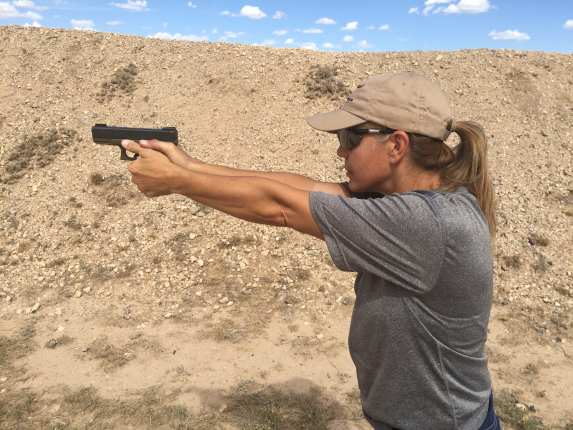By Interest
The DIY Guide to Fixing Shooting Errors, Vol. 2
Last week, we covered tips for diagnosing and fixing the most common pistol shooting errors. This week, we examine three classic mistakes that new and even experienced, but untrained, shooters sometimes make. These mistakes are usually the ones that prevent even seasoned shooters from achieving the next level of accuracy. The good news is, these mistakes are easily overcome with the right technique.
Published
1 year agoon
By
Eve Flanigan
Last week, we covered tips for diagnosing and fixing the most common pistol shooting errors. This week, we examine three classic mistakes that new and even experienced, but untrained, shooters sometimes make. These mistakes are usually the ones that prevent even seasoned shooters from achieving the next level of accuracy. The good news is, these mistakes are easily overcome with the right technique.
As for fixing these errors, first, of course, is understanding the problem. This advice, and the exercises I hope you’ll practice, are building blocks on the path to better marksmanship. You’ll notice none of this week’s instruction is stuff you’ll likely have time to think about if you must fire in a defensive encounter, or even in a shooting match. That’s okay—the more you practice these skills and make them automatic, the better you’ll perform in a stressful situation.
Error #1: Failure to focus on the front sight

Focused on the front sight look thru the rear.
The human eye, and most camera lenses for that matter, can only focus on one distance at a time. The rest of the view is a blur. Try it right now. Focus on any object and as you do, take note of the appearance of things more distant from it, as well as things between you and the object. That other stuff is blurry, huh?
Shooting is much the same. There are three distances on which we can focus, unless we’re shooting with an optic of some sort. There’s close (the rear sight, closest to the grip), medium (the front sight, closest to the muzzle), and far (the target, no matter the distance).
This is the one aspect of great marksmanship that goes against every instinct. It seems to make sense to focus on the target. Work with me here, though, and try this at the range. Having a fairly small target will help. An eight- or ten-inch paper plate, secured to a larger piece of backing material, is economical and ideal for starters. You can even draw a one-inch bullseye in the middle to help your aim.
Now, raise your firearm to a shooting position and align your sights. Hopefully you already know about centering the front sight between the dots, pillars, ears, or whatever the shape is of your rear sight. Do this as you look through, not over, the rear sight.

Sights on target
Center those aligned sights on target, so the top of your sights cover the bottom half of the target.
Pause here and check what’s going on. Chances are, you’re looking at the target, and getting really frustrated because the perfectly aligned sights refuse to stay perfect for more than a micro-second. That’s alright, we’re going to fix that, thankfully without stopping the glorious symptoms of life, like heartbeat and breath, that are the main cause. The wind may even be pushing your perfectly-gripped gun, and you in your perfect stance, around. It’s still okay—we got this.
Now, move your focus from the target to the front sight. Notice when you’re focused there, the target and the rear sight are just a blur. Now it’s time to press the trigger, maintaining your focus on the front sight.
If you haven’t tried this technique, you’re reading this and thinking I’ve lost my marbles. You WILL, I promise, become a better shooter by practicing front-sight focus. Do it as described, with attention to sight alignment first, and you’ll be able to make hits with your handgun at distances that amaze you.
If right now isn’t a good time to go to the range, you can approximate this exercise anywhere, so long as you’re not driving or something like that. Make a “V” with the index and middle fingers of one hand, and hold it at the approximate distance your handgun’s rear sight is from your face when shooting. Now, extend your other arm to full length and center the index finger of that hand between the V. Line your fingernails up to represent a three-dot sight system, in other words, they need to be in a horizontal line as you view them, though they’re separated if someone viewed you from the side. Now, pick something as a target—a doorknob or electrical outlet across an average-size room are usually good choices. Putting your aligned finger-sights over the target, practice focusing on the front sight, AKA the nail of your index finger. That’s exactly what to do with your real sights and target when you get to the range.

Stay focused on the front sight after the shot
The front sight focus technique is simple, and will help you shoot more accurately. It’s also easy to imagine forgetting all about the front sight if you’re shooting under stress. Practice enough that you can raise the gun to target, and within five yards or less, learn to press the trigger when the front sight is visible to you on the target. This can even be done with dry-fire if you reset the slide of your unloaded semiauto after every trigger press. That kind of practice will begin to meld the technique into something fast and accurate, which immensely benefits you in defense or competition.
Why did I say within five yards or less? At that distance, the rear sights are basically immaterial. As distance increases, and/or as the size of the target decreases, that initial rear/front sight alignment must be in place—if it’s not, your shots may not hit the target at all.
Error 2: Failure to follow through
Although our focus here is handguns, this principle applies to other kinds of firearm shooting. Many folks, often in an admirable attempt to be safe and sometimes simply from being excited about shooting, pop their finger off the trigger the moment the shot breaks. While keeping your finger off the trigger is absolutely critical when you don’t intend to shoot at that moment, you are indeed shooting now, and that snappy motion doesn’t serve you for accuracy or efficiency in making follow-up shots. It also costs you the opportunity to learn from the shot you just took.

The shot just fired. Still holding the trigger back as I reestablish front sight focus.
A fair amount of effort went into getting a good stance, grip, sight alignment, sight picture, and hopefully a steady, straight trigger press. If it’s your intent to fire even one more shot in that moment, you’ve thrown much of that nice setup away in the moment your finger came away as if the trigger were suddenly a hot iron. This change begins in slowing down your mental process while shooting. You must begin to see the trigger press, and the recoil that follows it, as nothing to get excited about.
You want to move from shooting multiple shots with the mercurial mind/finger connection represented by this graph…

…to firing shot sequences with a steady mindset that, if we graphed it, looks more like this:

I hope these graphics communicate that you need to breathe and simply concentrate on the front sight as your finger goes about its fairly boring job. The gun will fire just fine. Your job is to provide a stable platform.
You can help yourself by maintaining physical contact with the trigger between shots. This is best accomplished by holding the trigger back—I mean all the way back-after the shot is fired. Use that time to confirm that your sights are aligned again, and then decide to either take your finger to the straight/safe position, or allow the trigger to push it forward in preparation for the next shot.

Maintaining physical contact with trigger between shots
Borrowing a line from the excellent Appleseed rifle program, it’s also helpful to take a mental snapshot of where the sights were on the target at the moment the shot broke. You must be focused on the front sight—or red dot or crosshairs if you’re using an optic—in order to do that.
These fixes require that you keep your eyes, or at least your shooting eye, open throughout the firing sequence. Remember to breathe—for whatever reason, that’ll help you relax your eyes and your trigger finger.
Error #3: Checking the target
Related to follow-through, especially when practicing multiple-shot sequences, is the error of what I call checking. That is, the person wants to see where the shot landed on paper instead of attending to the follow-through process. If your sights aren’t broken or obviously out of whack, and you focused on the front sight with decently aligned sights, I promise you the shot is right in the bullseye or very close! Shooters who check prematurely soon begin to frustrate themselves with shot groups that are too low. In the time it took for the cartridge to ignite and send the bullet down the barrel, their quest for the perfect hit is foiled by the act of drooping the muzzle and raising their head to look at the target. The hole’s position won’t change in the moment it takes to follow through!

Checking pushes the muzzle downward
Checking is a less common error, but shows up often enough, usually in folks who are perfectionists off the range, that it bears mention. Perfectionistic traits usually serve their owners well….just resist premature checking of the target.
Putting it all together
Self-taught shooters, please try the techniques described here and in the first installment. If you have questions or requests for fixing other shooting challenges, please put them in the comments. I’m not always able to respond directly, but I do take comments into consideration for future articles. Shooting isn’t a skill you can learn on the internet—you’ve got to get to the range. Happy shooting! Have you liked our Facebook page yet?
You may like

CZ 75 SP01 Tactical Gun Review | Gun Carrier

PODCAST: Gun Law Changes All Across America Right Now

PODCAST: How to Win Olympic Gold

PODCAST: 50 Important Ideas For Self-Defense, Self-Reliance, and Personal Safety

10 Best Gun Safes In 2022 | Gun Carrier

DP-12 | Double Barrel Pump Shotgun Gun Full Review


